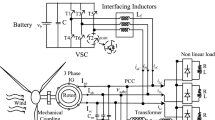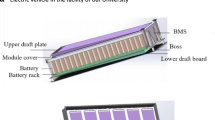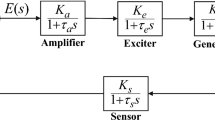Abstract
One of the main challenges in power converters is to adopt a convenient controller that is designed with an appropriate approach. In terms of controllers, linear and nonlinear types are available. Nonlinear controllers may be good for achieving dynamic capabilities; however, designing them involves undesirable complexity. Thus, alternative linear counterparts are desirable to achieve optimum performance. Fractional-order proportional-integral derivative (FOPID) controller stands as a good choice for this purpose since it is a more capable version of one of widely adopted linear controller known as PID. Therefore, in this study, a FOPID controller was used to achieve optimum performance for a buck converter. To obtain the best performance, a novel hybridized metaheuristic algorithm, which combines both Lévy flight distribution and simulated annealing algorithms (LFDSA), was utilized. The developed algorithm involves a balanced structure in terms of explorative and exploitative phases, which was confirmed via performing related analysis on unimodal and multimodal benchmark functions. Non-parametric statistical test has also showed the better capability of the proposed algorithm. Due to its enhanced capability, the proposed algorithm helped achieving optimum values of FOPID parameters such that a better closed-loop output voltage control performance of the buck converter in terms of time and frequency domain responses as well as disturbance rejection have been achieved. The proposed LFDSA-based FOPID controller also tested against other capable and reported state-of-the-art algorithm and the results have also verified the superior capability of the LFDSA over other approaches.















Similar content being viewed by others
References
Leng, M.; Zhou, G.; Tian, Q.; Xu, G.; Zhang, X.: Improved small-signal model for switching converter with ripple-based control. IEEE Trans. Ind. Electron. 68, 222–235 (2021). https://doi.org/10.1109/TIE.2020.2965478
Li, J.; Wu, A.: Influence of non-ideal factors on the boundary control of buck converters with curved switching surfaces. IEEE Access. 7, 52790–52803 (2019). https://doi.org/10.1109/ACCESS.2019.2912449
Kapat, S.; Krein, P.T.: A tutorial and review discussion of modulation, control and tuning of high-performance DC-DC converters based on small-signal and large-signal approaches. IEEE Open J. Power Electron. 1, 339–371 (2020). https://doi.org/10.1109/ojpel.2020.3018311
Hekimoğlu, B.; Ekinci, S.: Optimally designed PID controller for a DC-DC buck converter via a hybrid whale optimization algorithm with simulated annealing. Electrica. 20, 19–27 (2020). https://doi.org/10.5152/ELECTRICA.2020.19034
Tepljakov, A.: FOMCON: fractional-order modeling and control toolbox. In: Fractional-order modeling and control of dynamic systems. pp. 107–129. Springer (2017)
Demirören, A.; Ekinci, S.; Hekimoğlu, B.; Izci, D.: Opposition-based artificial electric field algorithm and its application to FOPID controller design for unstable magnetic ball suspension system. Eng. Sci. Technol. an Int. J. 24, 469–479 (2021). https://doi.org/10.1016/j.jestch.2020.08.001
Ekinci, S.; Izci, D.; Hekimoğlu, B.: Optimal FOPID speed control of DC motor via opposition-based hybrid manta ray foraging optimization and simulated annealing algorithm. Arab. J. Sci. Eng. 46, 1395–1409 (2021). https://doi.org/10.1007/s13369-020-05050-z
Morsali, J.; Zare, K.; Tarafdar Hagh, M.: Applying fractional order PID to design TCSC-based damping controller in coordination with automatic generation control of interconnected multi-source power system. Eng. Sci. Technol. an Int. J. 20, 1–17 (2017). https://doi.org/10.1016/j.jestch.2016.06.002
Bingul, Z.; Karahan, O.: Comparison of PID and FOPID controllers tuned by PSO and ABC algorithms for unstable and integrating systems with time delay. Optim. Control Appl. Methods. 39, 1431–1450 (2018). https://doi.org/10.1002/oca.2419
Bhookya, J.; Jatoth, R.K.: Optimal FOPID/PID controller parameters tuning for the AVR system based on sine–cosine-algorithm. Evol. Intell. 12, 725–733 (2019). https://doi.org/10.1007/s12065-019-00290-x
Shah, P.; Agashe, S.: Review of fractional PID controller. Mechatronics. 38, 29–41 (2016). https://doi.org/10.1016/j.mechatronics.2016.06.005
Izci, D.; Ekinci, S.: Comparative performance analysis of slime mould algorithm for efficient design of proportional–integral–derivative controller. Electrica. 21, 151–159 (2021). https://doi.org/10.5152/electrica.2021.20077
Hekimoglu, B.: Optimal tuning of fractional order PID controller for DC motor speed control via chaotic atom search optimization algorithm. IEEE Access. 7, 38100–38114 (2019). https://doi.org/10.1109/ACCESS.2019.2905961
Bozorgi, A.M.; Fereshtehpoor, V.; Monfared, M.; Namjoo, N.: Controller design using ant colony algorithm for a non-inverting buck-boost chopper based on a detailed average model. Electr. Power Components Syst. 43, 177–188 (2015). https://doi.org/10.1080/15325008.2014.975385
Mini, M.; Suresh, L.P.: Comparative evaluation of bio-inspired controller for a buck-boost converter. Aust. J. Basic Appl. Sci. 9, 361–366 (2015)
Tulay, G.; İskender, İ; Erdem, H.: Optimal tuning of a boost PFC converter PI controller using heuristic optimization methods. Int. Trans. Electr. Energy Syst. 27, e2458 (2017). https://doi.org/10.1002/etep.2458
Banerjee, S.; Ghosh, A.; Rana, N.: An improved interleaved boost converter with PSO-based optimal type-III controller. IEEE J. Emerg. Sel. Top. Power Electron. 5, 323–337 (2017). https://doi.org/10.1109/JESTPE.2016.2608504
Ekinci, S.; Hekimoglu, B.; Eker, E.; Sevim, D.: Hybrid firefly and particle swarm optimization algorithm for PID controller design of buck converter. In: 3rd International Symposium on Multidisciplinary Studies and Innovative Technologies, ISMSIT 2019 - Proceedings. pp. 1–6 (2019)
Izci, D.; Ekinci, S.; Orenc, S.; Demiroren, A.: Improved artificial electric field algorithm using nelder-mead simplex method for optimization problems. In: 2020 4th International Symposium on Multidisciplinary Studies and Innovative Technologies (ISMSIT). pp. 1–5. IEEE (2020)
Eker, E.; Kayri, M.; Ekinci, S.; Izci, D.: A new fusion of ASO with SA algorithm and its applications to MLP training and DC motor speed control. Arab. J. Sci. Eng. 46, 3889–3911 (2021). https://doi.org/10.1007/s13369-020-05228-5
Houssein, E.H.; Saad, M.R.; Hashim, F.A.; Shaban, H.; Hassaballah, M.: Lévy flight distribution: a new metaheuristic algorithm for solving engineering optimization problems. Eng. Appl. Artif. Intell. 94, 103731 (2020). https://doi.org/10.1016/j.engappai.2020.103731
Ekinci, S.; Hekimoğlu, B.; Izci, D.: Opposition based Henry gas solubility optimization as a novel algorithm for PID control of DC motor. Eng. Sci. Technol. an Int. J. 24, 331–342 (2021). https://doi.org/10.1016/j.jestch.2020.08.011
Kirkpatrick, S.; Gelatt, C.D.; Vecchi, M.P.: Optimization by simulated annealing. Science. (80-.)220, 671–680 (1983). https://doi.org/10.1126/science.220.4598.671
Mafarja, M.M.; Mirjalili, S.: Hybrid whale optimization algorithm with simulated annealing for feature selection. Neurocomputing. 260, 302–312 (2017). https://doi.org/10.1016/j.neucom.2017.04.053
Sayed, G.I.; Hassanien, A.E.: A hybrid SA-MFO algorithm for function optimization and engineering design problems. Complex Intell. Syst. 4, 195–212 (2018). https://doi.org/10.1007/s40747-018-0066-z
Çelik, E.; Öztürk, N.: A hybrid symbiotic organisms search and simulated annealing technique applied to efficient design of PID controller for automatic voltage regulator. Soft Comput. 22, 8011–8024 (2018). https://doi.org/10.1007/s00500-018-3432-2
Pan, X.; Xue, L.; Lu, Y.; Sun, N.: Hybrid particle swarm optimization with simulated annealing. Multimed. Tools Appl. 78, 29921–29936 (2019). https://doi.org/10.1007/s11042-018-6602-4
Gupta, S.; Deep, K.: A novel hybrid sine cosine algorithm for global optimization and its application to train multilayer perceptrons. Appl. Intell. 50, 993–1026 (2020). https://doi.org/10.1007/s10489-019-01570-w
Kurtuluş, E.; Yıldız, A.R.; Sait, S.M.; Bureerat, S.: A novel hybrid Harris hawks-simulated annealing algorithm and RBF-based metamodel for design optimization of highway guardrails. Mater. Test. 62, 251–260 (2020). https://doi.org/10.3139/120.111478
Nayak, J.R.; Shaw, B.; Sahu, B.K.: Implementation of hybrid SSA-SA based three-degree-of-freedom fractional-order PID controller for AGC of a two-area power system integrated with small hydro plants. IET Gener. Transm. Distrib. 14, 2430–2440 (2020). https://doi.org/10.1049/iet-gtd.2019.0113
Micev, M.; Ćalasan, M.; Ali, Z.M.; Hasanien, H.M.; Abdel Aleem, S.H.E.: Optimal design of automatic voltage regulation controller using hybrid simulated annealing: Manta ray foraging optimization algorithm. Ain Shams Eng. J. (2020). https://doi.org/10.1016/j.asej.2020.07.010
Shahidul Islam, M.; Rafiqul Islam, M.: A hybrid framework based on genetic algorithm and simulated annealing for RNA structure prediction with pseudoknots. J. King Saud Univ. - Comput. Inf. Sci. (2020). https://doi.org/10.1016/j.jksuci.2020.03.005
Wolpert, D.H.; Macready, W.G.: No free lunch theorems for optimization. IEEE Trans. Evol. Comput. 1, 67–82 (1997). https://doi.org/10.1109/4235.585893
Kennedy, J.; Eberhart, R.: Particle swarm optimization. In: Proceedings of ICNN’95-International Conference on Neural Networks. pp. 1942–1948. IEEE (1995)
Karaboga, D.; Basturk, B.: A powerful and efficient algorithm for numerical function optimization: artificial bee colony (ABC) algorithm. J. Glob. Optim. 39, 459–471 (2007). https://doi.org/10.1007/s10898-007-9149-x
Javidrad, F.; Nazari, M.: A new hybrid particle swarm and simulated annealing stochastic optimization method. Appl. Soft Comput. J. 60, 634–654 (2017). https://doi.org/10.1016/j.asoc.2017.07.023
Michiels, W.; Aarts, E.; Korst, J.: Theoretical Aspects of Local Search. Springer, Berlin (2007)
Schneider, J.J.; Puchta, M.: Investigation of Acceptance Simulated Annealing: A Simplified Approach to Adaptive Cooling Schedules. Phys. A Stat. Mech. Appl. 389, 5822–5831 (2010). https://doi.org/10.1016/j.physa.2010.08.045
Hajek, B.: Cooling Schedules for Optimal Annealing. Math. Oper. Res. 13, 311–329 (1988). https://doi.org/10.1287/moor.13.2.311
Smedley, K.; Ćuk, S.: Switching Flow-Graph Nonlinear Modeling Technique. IEEE Trans. Power Electron. 9, 405–413 (1994). https://doi.org/10.1109/63.318899
Kuo, B.C.: Automatic Control Systems. Wiley, New York (2003)
Ekinci, S.; Hekimoğlu, B.; Demiroren, A.; Kaya, S.: Harris hawks optimization approach for tuning of fopid controller in DC-DC buck converter. In: 2019 International Conference on Artificial Intelligence and Data Processing Symposium, IDAP 2019. pp. 1–9 (2019)
Oustaloup, A.; Levron, F.; Mathieu, B.; Nanot, F.M.: Frequency-band complex noninteger differentiator: characterization and synthesis. IEEE Trans Circuits Syst I Fundam. Theory Appl. 47, 25–39 (2000). https://doi.org/10.1109/81.817385
Gaing, Z.L.: A particle swarm optimization approach for optimum design of PID controller in AVR system. IEEE Trans. Energy Convers. 19, 384–391 (2004). https://doi.org/10.1109/TEC.2003.821821
Dorf, R.C.: Modern Control Systems. Pearson, Boston (2011)
Hekimoǧlu, B.; Ekinci, S.; Kaya, S.: Optimal PID controller design of DC-DC buck converter using whale optimization algorithm. In: 2018 International Conference on Artificial Intelligence and Data Processing, IDAP 2018. pp. 1–6 (2019)
Author information
Authors and Affiliations
Corresponding author
Rights and permissions
About this article
Cite this article
Izci, D., Ekinci, S. & Hekimoğlu, B. Fractional-Order PID Controller Design for Buck Converter System via Hybrid Lévy Flight Distribution and Simulated Annealing Algorithm. Arab J Sci Eng 47, 13729–13747 (2022). https://doi.org/10.1007/s13369-021-06383-z
Received:
Accepted:
Published:
Issue Date:
DOI: https://doi.org/10.1007/s13369-021-06383-z




